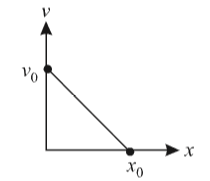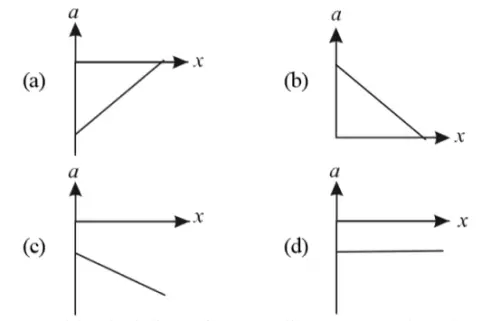 The most suitable acceleration-displacement graph will be. [IIT 05]
The most suitable acceleration-displacement graph will be. [IIT 05] 
Question 1:- The displacement (in meter) of a particle moving along x-axis is given by $x=18t+5t^2$. Calculate
(i) Instantaneous velocity at $t=2s$
(ii) average velocity between $t=2s$ and $t=3s$,
(iii) Instantaneous acceleration.
Solution:- Given in the question that
$x=18t+5t^2$
(i) we know that velocity
\begin v &=\frac \\ & =\frac(18t+5^>) \\ & =18+10t \\ \end To find velocity at $t=2s$, put $t=2$ in above equation.
So, Instantaneous velocity$=18+10\times 2=38m.^>$
(ii) displacement at $t=2$ is
$_>=18\times 2+5\times <^>=56m$
At $t=3$
$_>=18\times 3+5\times ^>=54+45=99m$
average velocity
$v=\frac<_>-_>><_>-_>>=\frac=43m^>$
(iii)
$a=\frac=\frac(18+10t)=10m^>$.
Question 2 :- The Displacement $x$ of a particle at time $t$ along a straight line is given by $x=\alpha -\beta t+\gamma t^2$. Find the acceleration of the particle. (Ans = $2\gamma $) Hint: - procedure same as above question.
Question 3 :- A car accelerates from rest at constant role $\alpha$ for some time, after which it decelerates at a constant rate $\beta$ and come to rest. If the total time elapsed is $t$ second, then calculate
(i) maximum velocity attained by the car
(ii) total distance travelled by the car in terms of $\alpha$, $\beta$ and $t$.
Solution :-
(i) let the car accelerate for the time $t$, and $v$ be the maximum velocity of the car at time $t_1$.
We know that
$v =u+at$
Therefore, $v =0+\alpha t_1$
or,
$t_1=\frac \qquad \qquad (1)$
Now starting with maximum velocity $v$, the car decelerates at constant rate $\beta$ and comes to rest in time $(t-t_1)$. Therefore,
$0=v-\beta (t-t_1)$
or,
$t-_>=\frac\qquad \qquad (2)$
Adding equations (1) and (2)
$t = \frac + \frac = v\left( >>> \right)$
or,
$v = \frac>>\qquad \qquad (3)$
This gives maximum velocity attained by the car.
(ii) distance covered by the car in time $t_1$ is
$_>=0+\frac\alpha t_^$
By using equation of motion
$x=ut+\fraca^>$
$_>=\frac\cdot <^>=\frac<-<^>>$
[using 1]
Distance travelled by the car in time $\left( t-_> \right)$ \begin x&=v (t-_>)-\frac\beta <<(t-_>)>^> \\ & = v\cdot \frac-\frac\beta\frac=\frac\\ \end (using epn2) Therefore total distance travelled by the car is
\begin x&=_>+_>=\frac<<^>>+\frac<<^>> \\ & =\frac<<^>>\left [ \frac+\frac \right ] \\ \end Using equation (3) and solving for x we get
$$x=\frac<\alpha \beta ^>><2(\alpha +\beta )>$$
Question 4 :- A race car accelerates on a straight road from rest to a speed of $180km^>$ in $25\, s$. Assuming uniform acceleration of the car throughout find the distance covered in this time.
Solution:-
Here $u=0, \, t=25 s$,
Given that
$v=180\, Km/h=\frac=50\, m/s$
Acceleration
$a=\frac=\frac=2\frac$
Distance,
\begin s&=ut+\fraca<^> \\ & =0\times 25+\frac\times 2\times ^> \\ & =625m. \\ \end
Question 5 :- A ball rolls down an inclined track $2 m $ long in $4s$. Find
(i) acceleration,
(ii) time taken to cover the second meter of the track and speed of the ball at the bottom of the track.
Solution :-
(i) Here it is given that
$s=2m, \, t = 4s, \, u =0$
as
$s=ut+\fracat^2$
Putting respective values we get
$2=0+\frac\times a\times 4^2$
or,
$a=0.25m/s^2$
(ii) Time taken to cover the first metre of track is given by
$1 = 0 + \frac \times 0.25\times t^2$
$ \Rightarrow = 8$
Or $t = 2\sqrt 2 = 2 \times 1.414=2.83 s $
Hence time taken to cover the second meter of track is
$= 4-2.83 = 1.17 s.$
(iii) Speed at the bottom,
$v = u + at = 0+0.25\times 4 = 1m/s$
Question 1- What do you understand by term acceleration and retardation distinguish between average acceleration and instantaneous acceleration.
Question 2- Represent graphically and explain the motion of an object when the object is under the following conditions
(i) object is at rest
(ii) object with uniform motion along straight line
(iii) object with accelerated motion along straight line
(iv) object with decelerated motion moving along a straight line.
Choose correct option to answer following questions.
Question 1 :- A body is covering distance in proportion to square of time. The acceleration of the body is
(a) increasing
(b) decreasing
(c) zero
(d) constant
Answer:- (d)
Question 2:- The relation between $t$ and distance $x$ is $t=\alpha x^2+\beta x$. Where $\alpha$ and $\beta$ are constants.
The retardation is
(a) $2\alpha v^3$
(b) $2\alpha \beta v^3$
(c) $2\beta v^3$
(d) $2\beta ^2 v^3$
Answer :- (a) Given that
\begin t=\alpha x^2+\beta x \\ \frac=2\alpha x\frac+\beta \frac \\ 1=2\alpha xv+\beta v\\ v\cdot (2\alpha x+\beta )=1\\ (2\alpha x+\beta) =\frac \end Again differentiating both the sides w.r.t. $t$ we get \begin 2\alpha \frac =-v^\cdot \frac \\ 2\alpha v=-v^\cdot acceleration \end $\Rightarrow \, acceleration\,=\,- 2\alpha v^3$
Hence,
$retardation \, =+2\alpha v^3$
Question 3 :- The velocity displacement graph of a particle moving along a straight line is shown.
 The most suitable acceleration-displacement graph will be. [IIT 05]
The most suitable acceleration-displacement graph will be. [IIT 05] 
Solution : - (a)
From the given velocity-displacement graph,
$slope=\frac_>>_>>$ ,
and intercept on y-axis is$v_0$
Thus equation for this graph will be
\begin v&=\fracx+v_0\,\, \left[ y=mx+c \right] \\ \frac&=-\frac\frac \\ a&=-\frac.v \\ &=-\frac\left[ -\fracx+v_0 \right] \\ &=\frac
Question 4 :- A car, starting from rest accelerates at the rate f through a distance s, then continues at constant speed for time t and then decelerates at the rate f/2 to come to rest. If the total distance traversed is 5 S, then [A1EE 05]
(a) $s=ft$
(b) $s=\fracft^2$
(c) $s=\fracft^2$
(d) $s=\fracft^2$
Solution :- (c)
For accelerated motion
$u=0,\, a = f\, and \, s = s$.
As,
$v^2-u^2=2as$
$\therefore$ $v_^-0^2=2fs$
or,
$v_1=\sqrt$
For uniform motion
$u=v_1=\sqrt, \, t=t$
Distance travelled,
$s_2=ut=\left( \sqrt \right) t$
For decelerated travelled
$u=\sqrt, \, a=-f/2, \, v=0$
As, $v^2-u^2=2as$
$0^2-\left( \sqrt \right) ^2=2\times \left( -f/2 \right) s_3$
distance travelled,
$s_3=2s$
given in the question total distance travelled is
$s+s_2+s_3=5s$
$s+\left( \sqrt \right) t+2s=5s$
or,
$\sqrtt=2s$
Squaring both sides me get
$s=\fracft^2$
Question 5 :- The acceleration of a particle is increasing linearly with time $t$ as $bt$. The particle starts starts from origin with an initial velocity $v_0$ .The distance travelled by the particle in time t will be
(a) $v_0t+\fracbt^2$
(b) $v_0t+\fracbt^2$
(c) $v_0t+\fracbt^3$
(b) $v_0t+\fracbt^3$
Question 1 :- Give an example which shows that a positive acceleration can be associated with a slowing down object.
Question 2 :- is the acceleration of a car greater than when accelerator is pushed to the floor or when break pedal is pushed hard.
Question 3 :- suppose the acceleration of a body varies with time. Then what does area under its acceleration – time graph for any time interval represent.
Question 4 :- The ϑ –t graphs of two objects make angle of and with the time axis. Find the ratio of their acceleration.
Question 5 :- is it possible that your cycle has northward velocity but southward acceleration? If yes, how?